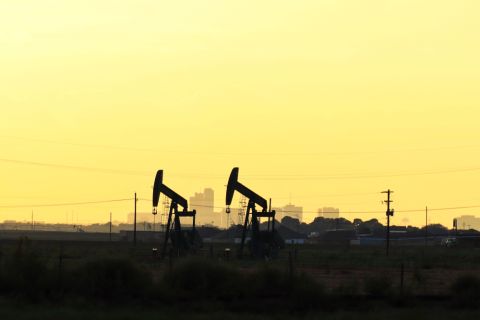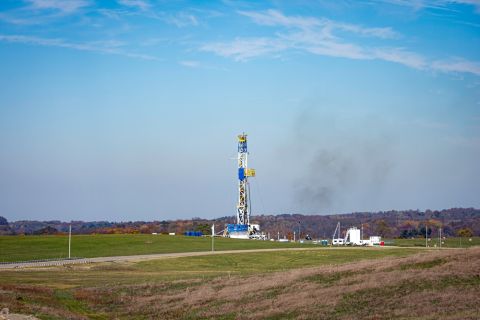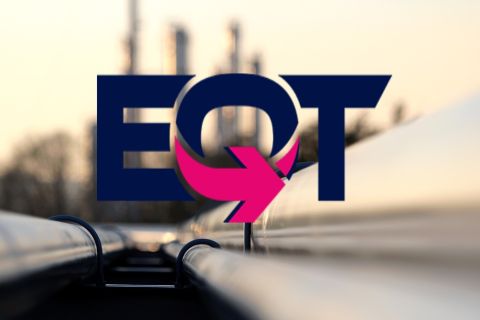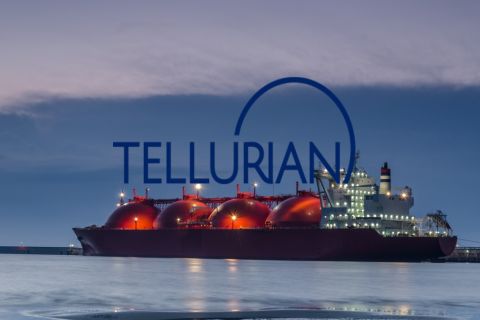One energy analyst recently called natural gas "the ugly stepsister" of the commodities. Another said natural gas prices had been range-bound so long that the fuel was "left for dead" by investors. What is an industry to do when Wall Street puts it in the penalty box for finding too much of a good thing?
"Once we realized that the industry had found a deep and rich supply of natural gas, we had to ask the question: What are we going to do about it?" says David Hill, vice president of natural gas economy operations for Encana Corp., Calgary.
"Early on in the shale-gas revolution, we made the observation that we have a team of 4,000 to 5,000 employees dedicated to finding oil and gas, but zero employees dedicated to growing demand."
That realization came about two years ago. Encana has since launched a number of initiatives, the first of which was to form the Natural Gas Economy group, an internal team whose mission, Hill explains, is to see natural gas become the cornerstone of the U.S. energy portfolio."We recruited some of the best people in our company to join this team," he says.
One of the group's first projects? Converting Encana's fleet of 1,300 light-duty field trucks and passenger vehicles to natural gas. "I like to say, 'Dairy farmers drink their own milk. How can we persuade other people to use natural gas, when we aren't using it ourselves?'"
To date, most of Encana's conversions are to bi-fuel engines. "Since CNG (compressed natural gas) fueling stations are sparse, we have opted for bi-fuel models to ensure a steady supply of fuel for vehicles with long-range trip requirements and remote operations. You can push a button and switch from natural gas to gasoline.
"As a result of some of our talks with the automakers, we have a commitment from one of the Big Three to begin production by the end of 2012 of a bi-fuel, light-duty pickup that we can use in our field operations. General Motors has also committed to manufacturing a dedicated-engine CNG van."
Private enterprise's role
Of course, one of the obstacles hampering the adoption of CNG as a transportation fuel is the lack of conveniently located fueling stations. Encana, Chesapeake Energy Corp. and other producers are moving to address this issue. In May, Encana opened a CNG fueling station about 30 miles north of Denver that will serve its field fleet as well as that of Anadarko Petroleum Corp. and Noble Energy Inc. Last year, Encana opened its first CNG fueling station in Louisiana servicing its Haynesville fleet.
It expects to open three additional stations this year–one in Wyoming and two in Canada. Some of these stations are expected to be open to the public, allowing communities to enjoy the economic and environmental benefits afforded by natural gas.
In May 2010, Chesapeake Energy's chief executive, Aubrey McClendon, announced plans to convert the company's entire fleet of 4,200 field vehicles to CNG by 2014. Chesapeake has now completed Phase I of the program, with some 800 vehicles operating out of its Oklahoma City office, making it one of the largest CNG fleet operators in the nation. Phase II will include fleet vehicles operating in the North Texas Barnett shale and in Louisiana's Haynesville shale plays. Phases III and IV call for converting the company's fleets in Pennsylvania, West Virginia, Colorado, Wyoming and South Texas.
Chesapeake expects to realize annual savings of at least $11 million in fuel costs once the entire fleet is converted. Like Encana, it has been active in the build-out of fueling infrastructure. In 2010, Chesapeake and its fuel retail partners, including OnCue Express, Pilot, Quick Trip, Total Express and Love's Travel Stops, opened new stations or added CNG pumps to existing facilities at 14 locations throughout Oklahoma. To date, Chesapeake has participated in opening 30 fueling stations across the country.
"Public CNG stations make it convenient for school districts, businesses, government and citizens to drive natural gas-powered vehicles and benefit from lower fuel prices," says Tom Price, Chesapeake's senior vice president of corporate development and government relations. "I drive a CNG Tahoe. I can fill up down the street at $1.39 per gasoline-gallon equivalent."

“How can we persuade other people to use natural gas, when we aren’t using it ourselves?” — David Hill, vice president, Encana’s natural gas economy operations
Manufacturing renewal
Like Encana, Chesapeake has an internal team focused on building natural gas demand.
Says Price, "I wouldn't characterize our efforts so much as trying to stimulate demand for natural gas. Rather, we are seeking policies that will help the U.S. stay competitive in the worldwide market.
"Natural gas is a very affordable energy source, and it can help lead us out of this recession. If harnessed properly, it has the potential to rejuvenate manufacturing in this country. We are seeing this in the petrochemical and chemical complex. The shale plays produce a lot of natural gas liquids and therefore ethane, which can be turned into plastics. In response, the chemical complex has recently announced several large-scale new plant construction projects that will create thousands of new jobs."
Price details some of Chesapeake's efforts to champion natural gas. "We are out talking to fleet owners, telling them about the cost savings they can achieve and educating them about the conversion process. We are working to expand the fueling infrastructure. We are working with our service companies and challenging them to convert their fleets to natural gas."
Encana has a similar program. "We are beginning to work with our vendors," says Hill. "We have service companies that haul pipe, water, dry goods, fracing equipment and more. All of these people could be running their trucks on natural gas. We have taken ourselves through the process of converting, and now we are educating others."
These efforts are paying off. In April, Encana announced an agreement with Heckmann Water Resources, a California-based water-hauling company active in the Haynesville shale. Heckmann recently ordered 200 new liquefied natural gas (LNG) trucks from Peterbilt Motors Corp. of Denton, Texas. This purchase makes Heckmann one of the largest LNG fleet providers in the country, and the first oil and gas service provider to use LNG to power its fleet.
Natural gas rigs
"We are beginning to convert our drilling rigs from diesel to natural gas," Hill says. "The industry now has 23 rigs running on natural gas, including 16 operated by Encana, five operated by Chesapeake and two operated by Noble."
Based on average daily fuel consumption, converting one rig to natural gas is roughly equivalent to removing 30 tractor trailers from the road. In addition, these rigs run on field gas, which allows the company to eliminate truck traffic associated with hauling in diesel fuel. While there is some upfront cost involved, given the fuel cost savings, Encana estimates a rig conversion pays for itself in about six to 18 months.
"Initially, we lacked the ability to use natural gas rigs in every play," says Hill. "For example, in the relatively new Haynesville play, we lacked sufficient pipeline infrastructure to transport field gas to the rigs. Then one of our guys had a 'Eureka!' moment. He asked, 'Why don't we bring in LNG to power our Haynesville rigs?'
"Since LNG can be transported anywhere, we saw this as a very workable solution, and implemented it."
Gearing up for exports
Another frontier for North American producers is the LNG export market. In March, Encana agreed to acquire a 30% interest in the planned Kitimat export terminal and associated pipeline, to be located on the west coast of British Columbia, north of Vancouver near the Port of Kitimat.
"Kitimat was originally supposed to be an LNG import facility; however, due to the dramatic increase in domestic natural gas supply, it was never built," notes Hill. "Apache Corp. is operator of the project with a 40% interest, and EOG Resources and Encana both hold a 30% interest. We are in the process of securing permits to turn this into an export facility. It is expected to be online by 2015. We plan to export Canadian gas to Asia, where natural gas is more closely tied to oil prices and is currently selling for $12 to $14 per MMBtu."
In addition to efforts on the part of individual companies, a number of producers are forming alliances and joining coalitions that support natural gas. One of the most influential to date is America's Natural Gas Alliance (ANGA), representing 30 of North America's largest independent E&P companies. Both Encana and Chesapeake were founding members of the alliance, which formed in early 2009 to raise awareness about the newfound abundance of natural gas—and to ensure its inclusion in the national political discourse about America's energy policy.
The alliance has been very active over the past two years, running public awareness ad campaigns, establishing an educational website, engaging with lawmakers and their staffs, meeting with utility executives and presenting at the U.S. Conference of Mayors. Due in part to these efforts, a number of cities are converting their city bus fleets and trash trucks to run on natural gas.
For example, the Dallas Area Rapid Transit (DART) recently awarded Clean Energy Fuels Corp. a $40-million contract to design and build four new CNG stations to support the transition of DART's fixed route and paratransit bus fleet to 100% CNG power. The project will also include two building modifications for maintenance facilities.
Over the next three years, the agency plans to deploy 452 new CNG buses and 200 CNG paratransit vehicles to replace its current fleet of LNG- and diesel-powered models that began service in 1998. The new Clean Energy CNG fueling stations will be located at DART's bus and paratransit maintenance facilities. The station development project was set to start in May 2011 and Clean Energy expects to complete DART's first new CNG fueling facility by April 2012.
"With the transition of its bus fleet to CNG power, DART joins the ranks of clear leaders among U.S. transit operators anxious to secure the environmental and economic benefits of CNG for their communities," said James Harger, Clean Energy's chief marketing officer.

“Public CNG stations make it convenient for school districts, businesses, government and citizens to drive natural gas-powered vehicles and benefit from lower fuel prices.” — Tom Price, senior vice president of corporate development and government relations, Chesapeake Energy Corp.
"Across the nation, Clean Energy is partnering with many transit agencies to reliably fuel over 5,500 buses daily."
Another key organization educating lawmakers and the public on the benefits of natural gas is the American Clean Skies Foundation. Based in Washington D.C., the non-profit's goal is to advance America's energy independence as well as a cleaner environment. The organization provides educational materials, generates research reports and teamed with the Bipartisan Policy Center to create a national task force to encourage policy changes that support more widespread use of natural gas for electric generation and transportation, according to Greg Staple, chief executive of the foundation.
The power sector
"We believe the power sector is the most likely to see dramatic near-term growth in natural gas usage," Staple says. This is due, in part, to seven EPA-proposed rules to address air and water quality concerns, including ozone, mercury, haze, ambient air quality, coal ash and greenhouse gas emissions. The rules are generally expected to be phased in between 2012 and 2016.
"Under these proposed rules, 15% to 20% of the country's legacy coal fleet of power generation plants is likely to be retired over the next five to seven years. Natural gas will almost certainly take up part of the slack as these plants are retired," Staple says.
"The likelihood of natural gas as a fuel of choice for power generation depends on how stable prices remain going forward. Significantly, forward price curves now indicate that natural gas is expected to remain below $6 per thousand cubic feet through 2018 and 2019," he notes.
"This allows chemical companies to make capital commitments to build new facilities, knowing that stable prices will enable them to recover their investment in a timely manner. Whether natural gas is to be used as a transportation fuel, as a feedstock for the chemical companies or for power generation, price stability is key to widespread acceptance by consumers, government, utilities and manufacturers."
On the electric-generation front, Encana recently announced a benchmark agreement with Northwest Natural Gas, an Oregon-based natural gas distributor. The long-term agreement calls for Northwest to invest about $250 million over five years to earn a working interest in certain sections of Encana's Jonah Field in Wyoming.
The deal gives Encana capital to advance its development of Jonah Field, while providing long-term price security for Northwest. Traditionally, utilities have purchased natural gas on short-term contracts from wholesale markets, with customers subject to fluctuating prices. This first-of-its-kind, direct producer-utility agreement helps secure long-term natural gas supply for Northwest at the cost of production rather than at future market prices.
"This landmark agreement is expected to open the door for future upstream investment by utilities seeking price stability for their customers. We hope it will serve as a model to spawn additional long-term contracts," Hill says.
Fueling corridors and clusters
Finally, natural gas vehicle (NGV) coalitions have been instrumental in formulating plans for natural gas fueling corridors across the country, and new alliances continue to be formed.
Back in 2009, Encana was a key participant in forming the Weld County (Colorado) Natural Gas Coalition, a public-private coalition. It includes various E&P companies, midstream and service companies, area colleges and local government leaders, and was established to promote the use of the state's rich reserve of natural gas. The coalition's 50-page plan charts a course for building a fueling infrastructure, converting fleets and encouraging consumers to adopt CNG vehicles, while establishing certificate programs at local colleges to prepare technicians to service CNG vehicles.

OnCue is a one of Chesapeake Energy Corp.’s fuel retail partners, offering CNG fueling stations.
Significantly, the plan will complete an alternative fuel corridor between Colorado and Wyoming by connecting the states along U.S. 85. Currently, Weld County represents a major hole in the local and regional fueling infrastructure for NGVs. The development of a Northern Front Range fueling network would connect southern Colorado with the existing Wyoming and Utah fueling network to the north.
The program, which is to be phased in over 10 to 15 years, is expected to ultimately support 10,000 or more consumer and fleet CNG vehicles serviced by 15 to 30 CNG and LNG stations in northern Colorado along U.S. 85.
Since the inaugural Weld County plan, four additional corridors have been proposed across the U.S. and Canada, as well as CNG fueling clusters around certain metropolitan areas, says Kathryn Clay, executive director of the Clean American Transportation Alliance. CATA, a newly formed joint initiative between ANGA and the American Gas Association (AGA), is seeking to support CNG fleet usage, infrastructure development, vehicle offerings and educational efforts.
Clay, who holds a PhD in applied physics and a master's in electrical engineering from the University of Michigan, Ann Arbor, has worked extensively on alternative-fuel vehicle research and policy development in both the public and private sectors.
"When I was doing research in the private sector, we were looking into fuel cells and flex fuel. NGV was not even on our radar. That is how much the energy landscape has changed since 2007," Clay says.
"Although 150 models of CNG vehicles are offered around the globe, currently the Honda Civic GX is the only light-duty vehicle offered in America. We are working with auto manufacturers to get a wider variety of vehicles available here. Manufacturers have announced a number of new models that will be offered in the next five years, and we're working with them to try to accelerate their timetable. We are also working toward getting a home-fueling kit offered at a price point of $1,500 or less."

Encana Corp. currently has 16 natural gas rigs. The company estimates a rig conversion pays for itself in about six to 18 months. -Source: Encana Corp.
The NAT GAS Act
According to a recent Raymond James & Associates report, assuming an expanding U.S. fueling infrastructure coupled with increased vehicle offerings, over the next five years we could see demand for natural gas in the transportation sector increase 10 times over its current level, to 1 billion cubic feet (Bcf) per day or more.
However, the report goes on to say, "to accelerate the adoption curve, a more potent commitment from Washington, along the lines of the currently pending NAT GAS Act, would be extremely useful."
The New Alternative Transportation to Give America Solutions Act (NAT GAS Act) was introduced in April and already has garnered more than 180 co-sponsors. The bill provides a $0.50-per-gallon excise tax credit for CNG and LNG for a period of five years, an infrastructure tax credit up to $100,000 per station and up to 80% off the incremental additional cost of an NGV.

“We believe the power sector is the most likely to see dramatic near-term growth in natural gas usage.” — Greg Staple, chief executive, American Clean Skies Foundation.
Richard Kolodziej, president of NGV America, the national trade association for the U.S. NGV industry, says, "I think there is a very good chance that the bill will pass. Our leaders are waking up to the fact that we are sending almost $1 billion overseas every day to purchase foreign oil—a fact that is crippling our economy.
"That said, the bill is facing some strong pushback. Opponents are saying the government shouldn't get involved in providing subsidies or picking winners and losers in the energy universe. However, if the bill passes, increased manufacturing should lead to new efficiencies and reductions in the cost of the vehicles, and eventually we won't need the tax credit any more. The bill is set to expire within five years of passage."
Chesapeake's Price adds, "Surprisingly, much work still needs to be done to convince our lawmakers that an adequate supply of natural gas exists and can serve any meaningful increase in demand. As an industry, we must work harder to make the case for shale gas.
"Our industry must make the case, every chance we get, that natural gas is the most obvious choice for a reliable, scalable, flexible, clean and abundant resource that can underpin economic and environmental renewal in this country."
Recommended Reading
Dallas Fed Energy Survey: Permian Basin Breakeven Costs Moving Up
2024-03-28 - Breakeven costs in America’s hottest oil play continue to rise, but crude producers are still making money, according to the first-quarter Dallas Fed Energy Survey. The situation is more dire for natural gas producers.
Aethon Cuts Rigs but Wants More Western Haynesville Acreage
2024-03-31 - Private gas E&P Aethon Energy has drilled some screamers in its far western Haynesville Shale play—and the company wants to do more in the area.
Ohio Oil, Appalachia Gas Plays Ripe for Consolidation
2024-04-09 - With buyers “starved” for top-tier natural gas assets, Appalachia could become a dealmaking hotspot in the coming years. Operators, analysts and investors are also closely watching what comes out of the ground in the Ohio Utica oil fairway.
EQT Ups Stake in Appalachia Gas Gathering Assets for $205MM
2024-02-14 - EQT Corp. inked upstream and midstream M&A in the fourth quarter—and the Appalachia gas giant is looking to ink more deals this year.
Which Haynesville E&Ps Might Bid for Tellurian’s Upstream Assets?
2024-02-12 - As Haynesville E&Ps look to add scale and get ahead of growing LNG export capacity, Tellurian’s Louisiana assets are expected to fetch strong competition, according to Energy Advisors Group.





